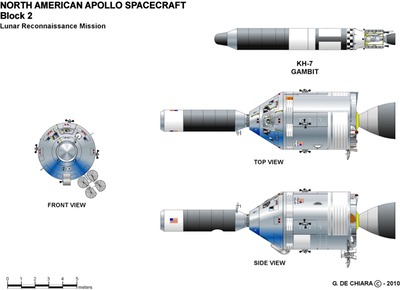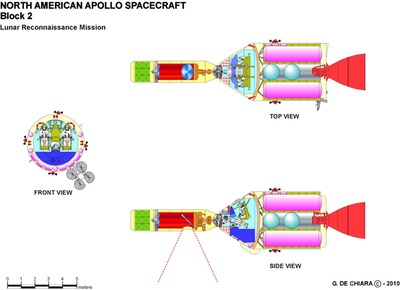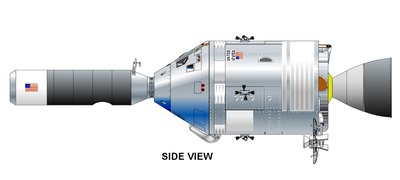Apollo: secrets and whispersby Dwayne A. Day
|
| The existence of the Lunar Mapping and Survey System was not classified, and actually appeared in an open source publication, a space encyclopedia aimed at kids that was produced in the later 1960s. |
As revealed by Vance Mitchell in the current issue of Quest, and discussed here last week (see “Black Apollo”, The Space Review, November 29, 2010), beginning in 1964 the NRO and NASA collaborated to allow NASA to use a modified KH-7 GAMBIT reconnaissance satellite on manned Apollo missions to photograph potential lunar landing sites. These missions were planned to occur in the event that the robotic Lunar Orbiter photographs were insufficient to determine if it was safe enough for an astronaut to land a Lunar Module on the surface. The KH-7 was then one of the two primary American reconnaissance satellites in service. NASA soon employed contractors Lockheed, General Electric, and Kodak to begin work on what was known as the Lunar Mapping and Survey System, or LM&SS. Details of the plan remain sketchy, but parts of hardware for four cameras were constructed before the program was canceled in summer 1967, after NASA determined that the Lunar Orbiter photographs were good enough to pick safe landing sites.
Thanks to the help of several people, further details have come to light. Space historian Tom Frieling noted that the existence of the Lunar Mapping and Survey System was not classified, and actually appeared in an open source publication, a space encyclopedia aimed at kids that was produced in the later 1960s. The encyclopedia indicated that the LM&SS missions would fly in lunar polar orbit and even produced a graphic showing an Apollo going around the Moon from pole to pole. It also mentioned that four systems were being built. It seems likely that the encyclopedia obtained this information from a trade industry source, such as Missiles & Rockets, or Aviation Week magazine, but I have not yet gone through these publications (which are not digitally archived) to find any references.
Rusty Barton found several NASA documents that mentioned the LM&SS system as part of a space station in Earth orbit. The documents even included simple line drawings of the exterior of the Lunar Mapping and Survey System, although no description of it. The LM&SS was depicted as a large cylinder that would be connected to the Apollo CSM docking port and then maneuvered into place on the space station. A couple of illustrations depict it inside a large truss structure that would hold it inside the Saturn Launch Adapter. Other illustrations show no truss structure. Although some kind of structure would have been required to carry the LM&SS inside the Saturn, at the time engineers had not decided if it was possible to pull the large camera out of the truss, or leave the truss attached. Leaving the truss attached had disadvantages. In Earth orbit the mass penalty would have been unimportant, but the truss would obscure the Command Module pilot’s vision and made it harder to attach to the space station. For lunar missions, carrying the truss’s mass all the way to lunar orbit might have been prohibitive. I have not yet discovered if an Apollo CSM spacecraft—let alone with an LM&SS attached—could have reached lunar polar orbit.
Although plans for the Lunar Mapping and Survey System initially called for it to be tested in Earth orbit, its depiction on the space station is confusing and probably not the original plan. As Tom Frieling outlined in an article in Spaceflight magazine several years ago, in the mid-1960s NASA officials had a lot of unrealistic ideas about what was called the Apollo Applications Program, or AAP. These plans included launching literally dozens of Skylab-sized space stations into Earth orbit, one every few months. NASA was never really clear what all these stations would do, and some of the ideas bordered on craziness, such as using astronauts to forecast the weather from space, something that was already being ably accomplished by the Tiros weather satellites.
Even though AAP planners apparently constructed a subscale mockup of the LM&SS for configuration checks on an orbital space station, it is unlikely that this was one of the initial plans for the simple reason that LM&SS was planned for testing in Earth orbit prior to operational use around the Moon, prior to the first Moon landing, and NASA had no plans to fly an AAP mission before a Moon landing. So the AAP use was probably something that would have happened if LM&SS was not required for the Moon landings but was already built. National Air and Space Museum historian Jim Davis has documented the turgid history of how senior government officials debated limits for NASA photography in Earth orbit, concerned about allowing a civilian agency to reveal too much information about American reconnaissance capabilities. Although the NRO was willing to let NASA use its powerful spy satellite camera around the Moon, it seems unusual, and unlikely, that they would have allowed the civilian agency to take photographs in Earth orbit equivalent to what NRO spysats were taking. Skylab was the only part of the Apollo Applications Program that survived, and it notably did not include the LM&SS system.
 Illustration of the exterior of an Apollo and LM&SS. A larger version is available. (credit: G. de Chiara) |
Giuseppe de Chiara has managed to produce artwork depicting the Lunar Mapping and Survey System attached to the Apollo CSM. Although he enjoys illustrating historical space projects, particularly spaceplanes, Giuseppe also has the knowledge to support his artwork, based on his work for Telespazio as the operations lead on a European Space Agency payload aboard the International Space Station. He recently returned from a year in France working at the ATV Control Center and is certified by ESA. and expects to be certified by NASA soon. In addition to this work, de Chiara is also a systems engineer on Italy’s IRENE multi-role reentry capsule, so he knows spacecraft. He has produced two illustrations of the Apollo and LM&SS, an exterior view showing the spacecraft in comparison to the KH-7 GAMBIT, and a cutaway view revealing the internal configuration of the system.
| Which of the Apollo missions—and which crews—would have flown a Lunar Mapping and Survey System around the Moon. Would it have been Apollo 8? Apollo 10? Would this have slipped the first landing to Apollo 12 or 13? |
The exterior view shows the relative sizes of the spacecraft. The KH-7 GAMBIT is depicted with its Agena upper stage attached. Based upon the recommendation of The Aerospace Corporation, starting with the first KH-7 launch in summer 1963 the Air Force chose to leave the Agena attached to the KH-7 for the first several missions. By this time the Lockheed Agena was a proven system and regularly provided stabilization and power for CORONA reconnaissance satellites. Although the KH-7 had its own power and stabilization system in the form of the General Electric Orbital Control Vehicle (OCV), project managers chose to play it safe and leave the Agena attached until after the camera system had operated successfully. Once the film had been returned to Earth, the Agena was detached and the OCV was put through its paces. But this early decision also served as an omen for General Electric, because when the time came to upgrade the system to the KH-8 model, Lockheed was able to successful demonstrate that the Agena was sufficient for the successful operation of the camera and the OCV was unnecessary; General Electric lost the contract.
The cutaway view shows the likely layout of the camera system based upon our informed speculation about the KH-7 GAMBIT. The reconnaissance camera was designed to operate unpressurized, and it is likely that the LM&SS would have done the same. At one end of the LM&SS spacecraft, where the KH-7 normally would have mounted a recovery vehicle for returning the exposed film to Earth, there was a cylinder and docking ring. After depressurizing the cabin, an astronaut wearing a pressure suit would have floated through the docking port and retrieved the canister containing the exposed film.
 Cutaway illustration of an Apollo and LM&SS. A larger version is available. (credit: G. de Chiara) |
Behind the canister with the film takeup reel would have been the film supply reel. The film path through the camera would have been much simpler than for the CORONA, where the film had to bend through several turns of 90 degrees or greater in vacuum without breaking. But it seems likely that the KH-7 film would have looped back and forth a few times before heading into the camera, to provide some slack for when the camera first started operation.
Mounted near the film supply and looking out the bottom (or side, depending on how you looked at it) of the LM&SS was a framing, or terrain, camera. This took large format, square pictures of the overall area that was being imaged at much higher resolution by the primary camera, serving like a small spotting scope mounted on the side of a larger telescope. These framing images proved vital for photo-interpreters to locate the position of images viewed much closer up. The terrain camera was also designed to produce images that could be precisely measured for mapping purposes. Terrain cameras were common for CORONA spacecraft, but according to some documents they were apparently not initially included in the GAMBIT system. They might have been even more necessary on the Moon where craters look remarkably alike.
Next to the film shutter and the platen that held the film flat would have been the camera’s 112-centimeter (44-inch) diameter reflecting mirror. One of the design constraints on the KH-7 was that the power and stabilization system was mounted at one end of a cylinder, and the reentry vehicle was mounted at the other end, meaning that designers had to find a way to enable the camera look out the side of the tube, down at the Earth. There are a couple of ways to do this, both requiring a large mirror to reflect the image of the Earth into the tube like a periscope. One method is to put the reflecting mirror at one end directing the image down the cylinder to a primary mirror that focused it onto a secondary mirror that then reflected it through a hole in the primary mirror and onto the film. In that configuration, the primary mirror would be closest to the film. But an alternative method does away with the secondary mirror—and its mass—entirely, by cutting a hole in the reflecting mirror and placing it, and not the primary mirror, near the film. The reflecting mirror bends the light coming in from the Earth (or Moon) below, and sends it to the primary mirror which concentrates it and sends it through a hole in the reflecting mirror and onto the film. The KH-7 and Lunar Mapping and Survey System most likely worked like this.
One thing missing from the illustration is a stellar imaging camera that would have photographed stars at the same time that the terrain and primary cameras were taking their photographs. The stellar images would have allowed photo-interpreters to precisely determine where the spacecraft was pointing when it took its pictures.
Behind the primary mirror would have been the OCV’s power systems in the form of batteries. The KH-7’s OCV was equipped with a cold gas stabilization system that one Aerospace Corporation engineer called a “bang-bang” system for the sound it made when its little jets fired on the ground. That stabilization system would have been unnecessary for the LM&SS, although the camera still required power and control electronics. Presumably, the Apollo spacecraft would have provided all the stabilization necessary.
 Illustration of an Apollo spacecraft on a Saturn V, with the LM&SS mounted in the place the Lunar Module would go. (credit: G. de Chiara) |
These new revelations raise several other interesting questions that require further study. One is the question of which of the Apollo missions—and which crews—would have flown a Lunar Mapping and Survey System around the Moon. Would it have been Apollo 8? Apollo 10? Would this have slipped the first landing to Apollo 12 or 13? A preliminary review of several Apollo schedule planning documents from the mid-1960s turned up no mention of LM&SS missions. LM&SS was a contingency system that would have flown only if the Lunar Orbiter missions did not produce sufficient quality imagery. But declassified and unclassified Apollo schedules from the time listed other contingency missions that were never flown. It is possible that the lunar mapping missions were not placed on the manifest, or that there was another, classified manifest. However, the period of 1964–1967 was one of great flux for Apollo planning, during which Apollo managers made major decisions about such things as the number of Saturn test flights that were necessary, and how best to recover from the Apollo 1 fire in January 1967. Potential plans for flying lunar reconnaissance missions made during this time period would have been completely overtaken by events.
A final question is the degree to which the awarding of the Lunar Orbiter contract to a team led by Boeing and Kodak was either pre-ordained or rigged by the team’s access to classified reconnaissance camera technology. Why go through the trouble of a competition if NASA’s agreement with the NRO to share technology had already picked a winner? NASA documents, and an official history, do not shed any light on this question, and it may only be answerable via interviews with the few living persons involved in this decision. There is obviously more research to be done on this intriguing topic.
Addendum: In the mid-1970s NASA produced a history of the Lunar Orbiter program titled Destination Moon. A searchable PDF (14 MB) is available here courtesy of the NASA History Office’s Colin Fries.
